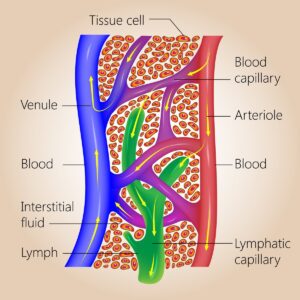Lymphatic drainage of the breast
 The lymphatic system is a core system that plays critical roles including but not limited to fluid hemostasis, the return of macromolecules and tissue fluids as well as systemic body immunity. In the pathology and treatment of breast cancer, identified as the most commonly diagnosed malignancy globally and the leading cause of mortality in women, the lymphatic drainage plays a significant role.
The lymphatic system is a core system that plays critical roles including but not limited to fluid hemostasis, the return of macromolecules and tissue fluids as well as systemic body immunity. In the pathology and treatment of breast cancer, identified as the most commonly diagnosed malignancy globally and the leading cause of mortality in women, the lymphatic drainage plays a significant role. 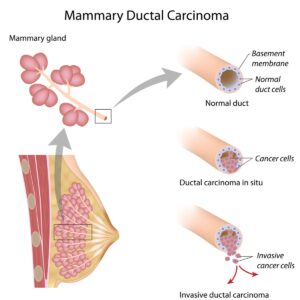 The most frequent route of malignant cells metastasize in the human body is through the lymphatic system, and therefore, in the determination of the cancer stage and the prognosis, it is essential to examine the lymphatic tissue. Lymph node harvesting advances over the recent past have significantly reduced the morbidity that is associated with the treatment of breast cancer. Furthermore, one of the side effects of breast cancer therapy; lymphatic vessel disruption has been linked to the significant morbidities associated with breast cancer.
The most frequent route of malignant cells metastasize in the human body is through the lymphatic system, and therefore, in the determination of the cancer stage and the prognosis, it is essential to examine the lymphatic tissue. Lymph node harvesting advances over the recent past have significantly reduced the morbidity that is associated with the treatment of breast cancer. Furthermore, one of the side effects of breast cancer therapy; lymphatic vessel disruption has been linked to the significant morbidities associated with breast cancer.
The lymphatic system is majorly comprised of:
- Lymphatic vessels
- Lymph
- Lymphatic tissue (tonsils, thymus gland, spleen, and the lymph nodes).
The lymphatic system is found in all body regions, with the exception of the bone marrow and the central nervous system. One property that distinguishes the lymphatic system from other systems is that it is a network of vessels that run parallel to the body’s blood vessels and allows for unidirectional flow of lymph under low pressure. 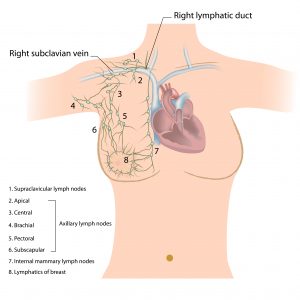
In comparison with the blood plasma, lymph, which is the commonest fluid that circulates within the lymphatic system, is composed of interstitial fluid, leukocytes, clotting factors, and proteins. The exchange of blood commonly takes place within the network of capillaries and mostly reenters to the venous circulation.
However, approximately 10% of the exchanged blood is ejected into the interstitial space and serves to maintain the fluid balance in the body. The capillaries within the lymphatic system have a single layer of endothelium that lines them and has loose junctions in the capillaries basement membrane to promote the entry of fluid, cells and macromolecules into the capillaries.
Structurally, lymphatic vessels are similar to veins as they contain valves and have a layer of smooth endothelial muscle that generates a pressure gradient that is maintained further through the coordinated action of contraction of skeletal muscles, gravity as well as respiratory movements. The lymphatic capillaries all drain into special pre-collectors, which subsequently drain to lymph nodes as well as collecting ducts. The efferents that originate from the lymph nodes merge into large lymphatic vessels and form regional lymphatic trunks.
The right upper trunk of the body, which includes the right breast and the right arm, all drain into the lymphatic duct, which then empties directly into the right subclavian vein. The remainder of the body, including the gastrointestinal tract, left breast and left arm as well as the lower extremities all drain into the thoracic duct that empties to the left subclavian vein in the body.
Lymph nodes
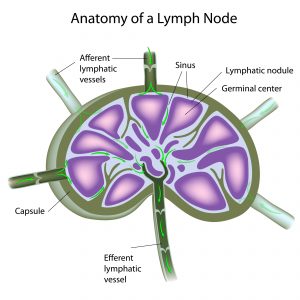 Structurally, lymph nodes are bean-shaped encapsulated structures that are distributed along with the lymphatic system and play a role in the filtration of tumor cells and microorganisms. The lymph nodes are an ideal location for the antigen presentation and, therefore, play a role in cellular immunity. There are three paired lymph node channels in the body; the axillary, cervical, and inguinal nodes, which are located at the axillae, neck, and groin in that order.
Structurally, lymph nodes are bean-shaped encapsulated structures that are distributed along with the lymphatic system and play a role in the filtration of tumor cells and microorganisms. The lymph nodes are an ideal location for the antigen presentation and, therefore, play a role in cellular immunity. There are three paired lymph node channels in the body; the axillary, cervical, and inguinal nodes, which are located at the axillae, neck, and groin in that order.
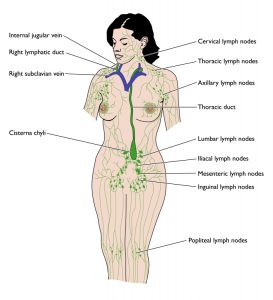 The afferent collectors of the lymphatic system drain into the sinuses located between the germinal centers within the nodes. The germinal centers comprise of the phagocytic cells, which include macrophages and play a role in the accumulation of foreign material, which include dyes used to localization of the lymph nodes as well as radiolabelled colloids during treatment of breast cancer.
The afferent collectors of the lymphatic system drain into the sinuses located between the germinal centers within the nodes. The germinal centers comprise of the phagocytic cells, which include macrophages and play a role in the accumulation of foreign material, which include dyes used to localization of the lymph nodes as well as radiolabelled colloids during treatment of breast cancer.
Based in Perth, Western Australia, Christine Comans is a Clinical Aesthetician, trainer and educator who specialises in intra dermal micro-pigmentation for women after mastectomy and breast reconstruction surgery. Chris is a strong advocate for industry standards and is renowned for her love of learning and sharing her knowledge.
Note from the Author: Sending you my heartfelt thanks for taking the time to read my blog. Over the last year I have been studying the lymphatic system and Manual Lymphatic Drainage (MLD) as part of my degree at the Australasian College of Health and Wellness. Recently I had the pleasure of performing the role of Clinical Supervisor for other degree students studying at the college. My role of clinical supervisor involved teaching a small group of outstanding professionals how to successfully perform the practical application of Manual Lymphatic Drainage MLD. Personally, I believe that MLD is a very underrated modality and now it’s my desire to preach the benefits to all.

